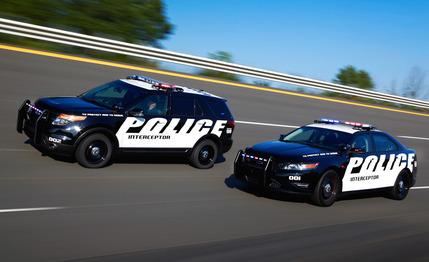
 First Drive Review
First Drive Review
From New York to New Orleans, cops and cabbies have more in common than a Plexiglas divider behind them: A fierce loyalty to primitive but durable rear-drive guzzlers.
But whether the cars are yellow or black-and-white, both types of drivers are seeing their loyalty tested by the forced retirement of pig iron—no pun intended, officer—like Ford’s Crown Victoria, which still holds 70 percent of the nation’s police-car market.
Now, both despite and because of their modern construction, fuel-saving V-6 engines, and standard all-wheel-drive, Ford hopes its new Police Interceptor Sedan and Utility will become leading suspects in police lineups nationwide. At Citi Field ballpark in Queens, Ford gave lead-footed auto writers—habitual springtime offenders on par with the Mets, who call Citi Field home—a rare perspective from the front seat of a cop car. They even let us play with the lights.
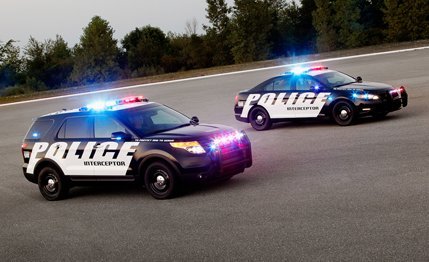

Ford’s first new, pursuit-certified police cars in 15 years are based on the Taurus and Explorer. Just don’t call them Taurus and Explorer. Ford says these heavily modified cruisers went through 28 months of track and real-world development, including input, testing and a thorough evaluation of their capabilities from the Los Angeles County Sheriff’s Department.
It’s Notah Taurus (or Explorer)
Ford claims unique engine calibrations for the Interceptors allow them to perform under the rigorous conditions expected from police service. The Interceptor sedan’s 3.5-liter V-6 adds variable valve timing to make 288 hp and 254 lb-ft of torque, the same 25-horse, 5-lb-ft gain made by the 2013 Taurus versus last year’s. There’s also an EcoBoost-equipped Interceptor sedan, with the Taurus SHO’s 365 hp and 350 lb-ft. The Interceptor Utility’s 3.7-liter V-6 makes 304 hp and 279 lb-ft of torque.
But if the engines are no stronger than those found in regular Fords, nearly everything else is as beefy and impervious as a desk sergeant. Compared to the outgoing Crown Vic, the new sedan’s brakes offer 60 percent more swept area and 53 percent better thermal management, and they have unique rotors, pads, seals, and stainless-steel pistons. A big-mouthed front fascia delivers more cooling air to fully vented rotors. Auxiliary oil coolers flank a radiator that is 50 percent larger than that of the consumer Taurus.
Heavy-duty shocks and springs and specially developed, 18-inch Goodyear Eagle RS tires allow 40-mph curb whacks with no tire blowouts or damage to black-steel rims. And the new models are certified to handle a brutal, 75-mph offset rear collision without spewing fuel. (You might remember when this was a newsworthy upgrade for Crown Vics.)
Inside, a nostalgic column shifter for the six-speed automatic frees up space on the extra-wide center console for computers and other gear. Fabric seats are tapered to accommodate officers’ bulky utility belts. “Anti-stab” plates in seatbacks prevent suspects from sticking in the knife. Optional ballistic doors, Ford says, are certified to block shots from Level 3 ammunition. Nineteen available colors include Michigan’s familiar and very cool State-Police blue, a shade that gives locals the willies just imagining it in their rearview mirror.
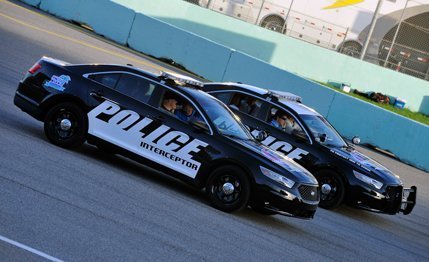

Key cylinders for ignition, trunk, and liftgate may seem old-fashioned, but they allow departments to cheaply cut their own keys and physically secure weapons and other expensive gear. Steering-wheel switches can be hardwired to manage aftermarket light bars, sirens, or other gear. Rubberized floors and vinyl seats can be quickly sanitized after hauling queasy drunks and other suspects to the station. “Customers in the back are sometimes not the cleanest customers,” says Bill Gubing, chief engineer of the Ford Police Program.
The Fords are equally fastidious in fuel consumption. The base V-6 sedan is EPA rated at 18/26 mpg, with the EcoBoost version at 16/23 mpg and the Utility at 16/22 mpg. Compared with the Crown Vic, the sedans burn up to 35 percent less fuel when idling, a big deal for cops: An Ottawa, Canada, study suggested that the average police car idles for up to 6.7 hours in every 10-hour shift.
Behind the Wheel, Under the Bar
When it’s time to light the cherry top, the Fords drive like buttoned-down versions of the showroom cars. We tested a trusty black-and-white Crown Vic back-to-back with new models in autocross, slalom, and braking exercises.
The surprise was the venerable Victoria, one of the last Panther-chassis police packages to roll off the now-mothballed assembly line. With its rear wheels and 4.6-liter V-8 churning, the old Vic was a hoot to jack (Kojak?) around the course, burning rubber and sliding sideways in ’70s-detective style.
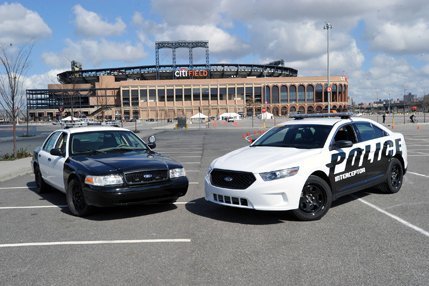

In contrast, the 21st-century toys were relentless understeerers, their front wheels threatening every orange cone when traction limits were exceeded. Ford engineers cringed when I suggested the old Vic was more fun to drive, and reminded me of the new Interceptor’s huge objective edge in grip, lap times, 0-to-100-mph acceleration, 100-to-0-mph braking, and balanced operation.
As mentioned, the Interceptor sedan and utility models come standard with all-wheel drive; both can be ordered in front-drive spec. In low-friction conditions such as on snow or ice, the AdvanceTrac stability-control system can send 100 percent of available torque to the front or rear wheels. Combined with traction control, the Interceptors do deliver evident advantages over the disco-era Crown Victoria. Don Kutschall, a longtime Skip Barber and police-driving instructor, said that the new Fords are faster, safer, and more predictable, allowing officers to focus on the task at hand and the scene ahead. “To help in any situation, they have to get there first,” Kutschall says. “This car will get them there without incident.”
Traditionalists, Gubing adds, once assumed that the only real police car is a sedan. But with the Utility mixing a high-speed pursuit rating with bonus real estate and an 800-pound load capacity, the Interceptor Utility may make converts out of them. (It will compete with the police-spec Chevy Tahoe and the newly announced Dodge Durango Special Service.)
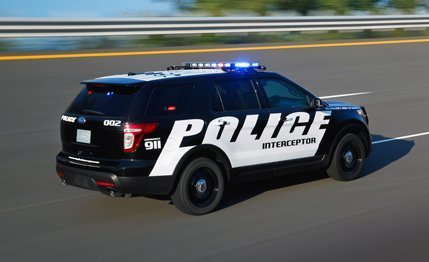

The purest boys in blue have also been known to grouse about the lack of a V-8. But Ford’s power-plus-economy pitch is familiar, even if we haven’t seen much in the way of real-world mileage gains in our tests. The twin-turbo EcoBoost, Gubing says, “can maximize takedowns and prevent high-speed pursuits before they even occur,” perhaps disappointing Dutch ecstasy dealers in Lamborghinis.
Blown Advantage
And in testing last November by the L.A. County Sheriff’s Department, the EcoBoosted Interceptor did smoke all comers, including Chevy’s Impala and new rear-drive Caprice PPV, and even Dodge’s 370-hp Hemi V-8 Charger Pursuit. The turbo Ford posted a 6.2-second 0-to-60 time, nearly a second quicker than the Dodge’s. The Ford also pocketed a two-second edge in average lap times over 32 go-rounds at the Auto Club Speedway in Fontana, California, and beat the Charger by four seconds on a city-pursuit course.
Unlucky drivers who find themselves outgunned by the Interceptor should keep license and registration at the ready. Or barring that, a handy line: “Don’t tase me, bro.”